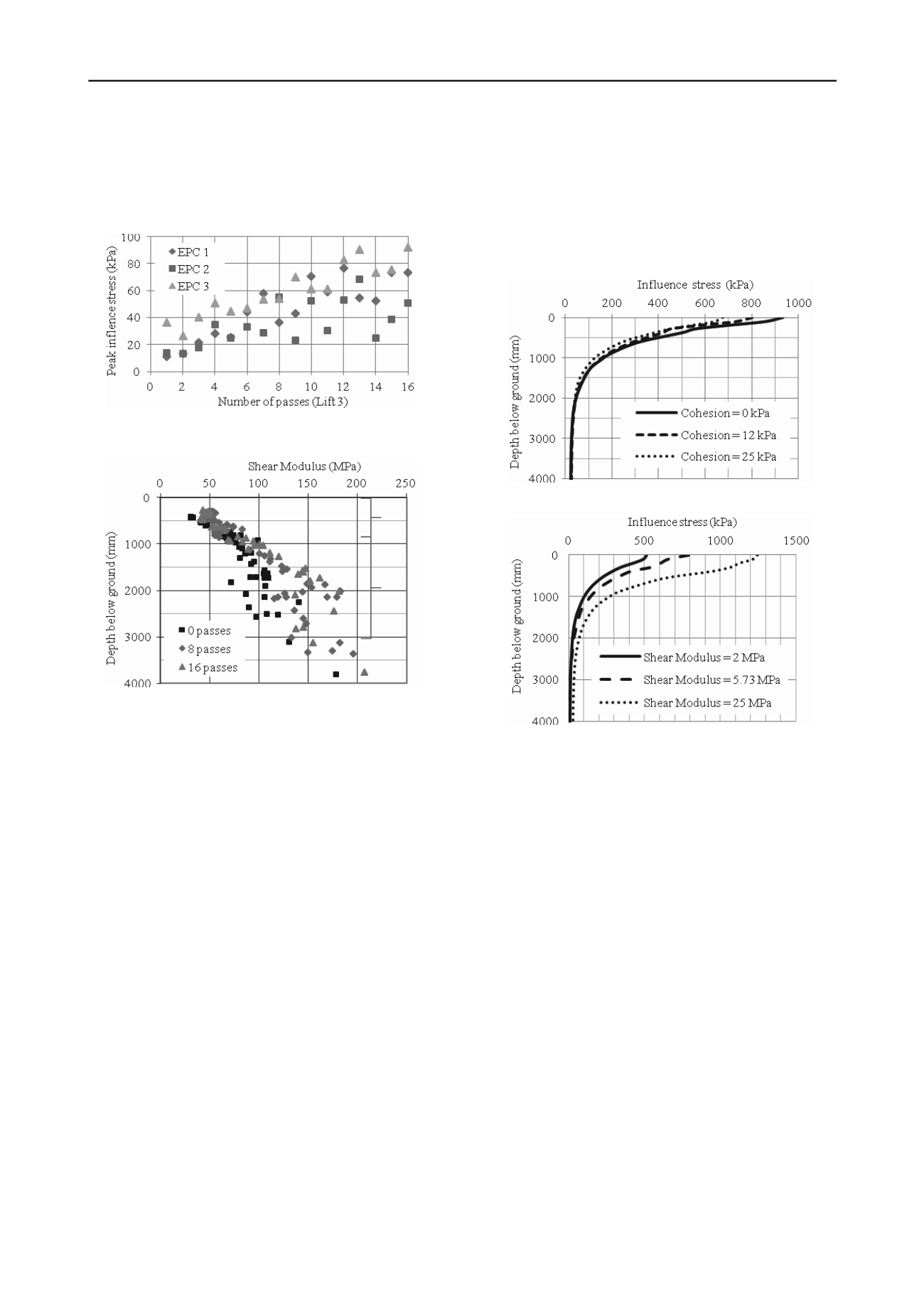
1312
Proceedings of the 18
th
International Conference on Soil Mechanics and Geotechnical Engineering, Paris 2013
a depth of 2.5 m (3.0 m in Figure 5), the varying numbers of
passes begin to converge, suggesting that this is the depth of
influence of the roller for which there is quantifiable
improvement. Below a depth of 2.5 m, results from field study
were inconclusive due to insufficient data points.
8 ACKNOWLEDGEMENTS
The authors wish to acknowledge Mr. Stuart Bowes and the
staff at Broons for their technical assistance with undertaking
site work and for supplying module drawings used in this study.
The authors also wish to acknowledge the research and
technical staff of the School of Civil, Environmental and
Mining Engineering at the University of Adelaide for their
valuable assistance.
Figure 7. Peak influence stress recorded by EPCs (Mentha et al. 2011).
(a)
Effective
Depth
Inconclusive
Figure 8. SASW test results for varying passes (Mentha et al. 2011).
(b)
6 RESULTS OF PARAMETRIC STUDIES
A limited series of parametric studies was undertaken. The
parameter that were examined were cohesion, shear modulus,
soil’s density, internal angle of friction, Poisson’s ratio, mass
and width of the roller and its application speed. It was found
that the soil parameters that were the most significant in terms
of the effectiveness of RDC were shear modulus, Poisson’s ratio
and cohesion (to a lesser extent). The variation of the module
mass and roller width were also found to significantly affect the
magnitude and depth of influence. Some of the results are
presented in Figure 9.
Figure 9. Results of parametric studies, varying: (a) cohesion; (b) shear
modulus.
9 REFERENCES
Avalle D.L. 2007. Trials and validation of deep compaction using the
“square” impact roller.
Australian Geomechanics Society, Chapter
Mini Symposium: Advances in Earthworks
, Sydney, Australia, 17
October, 1-7.
Avalle D.L. and Carter J. P. 2005. Evaluating the improvement from
impact rolling on sand. 6th
International Conference on Ground
Improvement Techniques
, Coimbra, Portugal, 18-19 July, 153-160.
7 CONCLUSIONS
This paper discussed and compared results obtained from a field
study by Jaksa et al. (2012) with those obtained from finite
element analysis modeling (FEM), to assess the effectiveness of
rolling dynamic compaction (RDC). The FEM was validated
against both theoretical solutions and field data obtained by
Mentha et al. (2011). The numerical model was found to predict
the soil settlement and soil stresses reasonably accurate for both
the static and dynamic cases. It was observed that large surface
deformations were noticeable within the first 0.8 m below the
ground, with RDC proving to be most effective between depths
of 0.8 m to 3.0 m. The soil within this effective depth range
demonstrated an increase in soil density with increasing number
of passes. A
preliminary
parametric study found that the most
significant factors were soil cohesion, Poisson’s ratio and shear
modulus, as well as the width and mass of the RDC module.
Avalle D.L., Scott B.T. and Jaksa M.B. 2009. Ground energy and
impact of rolling dynamic compaction – results from research test
site. 17th
Int. Conf. on Soil Mechanics and Geotech. Engrg.
,
Alexandria, Egypt, 5–9 October, Vol. 3, 2228–2231.
Bradley A., Crisp A.J, Jiang J. and Power C., 2012.
Assessing the
effectiveness of RDC using LS-DYNA.
Adelaide, Australia:
B.Eng.(Hons), The University of Adelaide.
Hallquist, J.O. (2006),
LS-DYNA Theory Manual
, Livermore Software
Technology Corp., March 2006.
Jaksa M.B., Scott B.T., Mentha N.L., Symons A.T., Pointon S.M.,
Wrightson P.T. and Syamsuddin E. 2012. Quantifying the zone of
influence of the impact roller.
Int. Symposium on Recent Research,
Advances and Execution Aspects of Ground Improvement Works
,
Brussels, Belgium, 30 May – 1 June, Vol. 2, pp. 41–52.
Kim K. 2011
. Impact rollers (soil compaction) numerical simulation of
impact rollers for estimating the influence depth of soil compaction
,
1
st
edition, Saarbrücken: LAP Lambert Academic Publishing
GmbH & Co
.
Mentha N., Pointon S., Symons A. and Wrightson P. 2011.
The
Effectiveness of the Impact Roller.
Adelaide, Australia:
B.Eng.(Hons), The University of Adelaide


